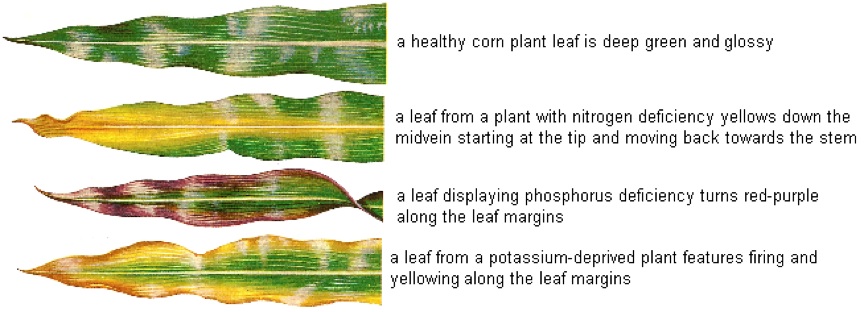Competency Area 1: Basic Concepts of Plant Nutrition
PO 4: Distinguish each macronutrient as mobile or immobile in the plant.
- The mobility of a nutrient in the soil determines how much can be lost due to leaching or runoff.
- The mobility of a nutrient in the plant determines where deficiency symptoms show up.
- Nutrients that are mobile in the plant will move to new growth areas, so the deficiency symptoms will first show up in older leaves.
- Nutrients that are not mobile in the plant will not move to new growth areas, so deficiency symptoms will first show up in the new growth.
Nutrient mobility varies among the essential elements, and represents an important consideration when planning fertilizer applications. For instance, NO3- nitrogen is very mobile in the soil, and will leach easily. Excessive or improper application increases the risk of water contamination. Meanwhile, phosphorus is relatively immobile in the soil, and is thus less likely to runoff. At the same time, it is also less available to plants, as it cannot "migrate" easily through the soil profile. Thus, P is often banded close to seeds to make sure it can be reached by starting roots.
Nutrients also have variable degrees of mobility in the plant, which influences where deficiency symptoms appear. For nutrients like nitrogen, phosphorus, and potassium, which are mobile in the plant, deficiency symptoms will appear in older leaves. As new leaves develop, they will take the nutrients from the old leaves and use them to grow. The old leaves are then left without enough nutrients, and display the symptoms. The opposite is true of immobile nutrients like calcium; the new leaves will have symptoms first because they cannot take nutrients from the old leaves, and there is not enough in the soil for their needs.

Quick Links
- Competency Area 1: Basic Concepts of Plant Nutrition
- Competency Area 2: Basic Concepts of Soil Fertility
- Competency Area 3: Soil Testing and Plant Tissue Analysis
- Competency Area 4: Nutrient Sources, Analyses, Application Methods
- Competency Area 5: Soil pH and Liming
- Competency Area 6: Nutrient Management and Planning
